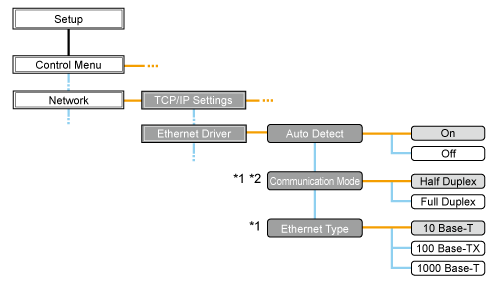
|
*1
|
[Communication Mode] and [Ethernet Type] are displayed when [Auto Detect] is set to [Off].
|
|
*2
|
[Communication Mode] appears only when [Ethernet Type] is set to a setting other than [1000 Base-T].
|
 |
Pressing [
 ] ( ] ( Settings) displays the common Setup menu. Settings) displays the common Setup menu. indicates that the procedure is performed by pressing [ indicates that the procedure is performed by pressing [  ] or [ ] or [  ] on the control panel. ] on the control panel.  indicates that the procedure is performed by pressing [OK] on the control panel. indicates that the procedure is performed by pressing [OK] on the control panel. |
|
IMPORTANT
|
|
After performing the configuration
To enable the settings, perform a hard reset or restart the printer.
For details on a hard reset, see "Canceling All the Jobs (Hard Reset)." To go back up the hierarchy
Press [
 ] ( ] ( Back). Back). About the control panel
For details on the control panel, see "Control Panel."
|
 ] (
] ( Settings), select [Network] using [
Settings), select [Network] using [  ] and [
] and [  ], and then press [OK].
], and then press [OK].
 |
You can specify the settings when the printer is either online (the
 Online indicator is on) or offline (the Online indicator is on) or offline (the  Online indicator is off). Online indicator is off). |
 ] and [
] and [  ], and then press [OK].
], and then press [OK].
 |
This printer can detect the communication method and Ethernet type automatically. Normally, set [Auto Detect] to [On].
If you want to fix the communication method and Ethernet type, set [Auto Detect] to [Off]. |
 |
If you are using a hub, match the settings for the hub and the printer. For the settings of the hub you are using, consult your network administrator.
|
|
(1)
|
Select [Auto Detect] using [
 ] and [ ] and [  ], and then press [OK]. ], and then press [OK]. |
|
(2)
|
Select [On] using [
 ] and [ ] and [  ], and then press [OK]. ], and then press [OK]. |
|
(1)
|
Select [Auto Detect] using [
 ] and [ ] and [  ], and then press [OK]. ], and then press [OK]. |
||||
|
(2)
|
Select [Off] using [
 ] and [ ] and [  ], and then press [OK]. ], and then press [OK]. |
||||
|
(3)
|
Select [Communication Mode] using [
 ] and [ ] and [  ], and then press [OK]. ], and then press [OK]. |
||||
|
(4)
|
Select an Ethernet communication method appropriate for your network environment using [
 ] and [ ] and [  ], and then press [OK]. ], and then press [OK].
|
||||
|
(5)
|
Select [Ethernet Type] using [
 ] and [ ] and [  ], and then press [OK]. ], and then press [OK]. |
||||
|
(6)
|
Select an Ethernet type appropriate for your network environment using [
 ] and [ ] and [  ], and then press [OK]. ], and then press [OK]. |
|
NOTE
|
|
For details on a hard reset
|